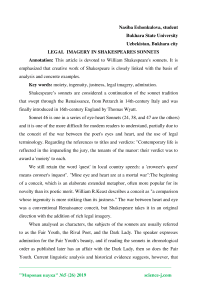Legal imagery in Shakespeares sonnets
Автор: Nasiba Eshonkulova
Журнал: Мировая наука @science-j
Рубрика: Основной раздел
Статья в выпуске: 5 (26), 2019 года.
Бесплатный доступ
This article is devoted to William Shakespeare's sonnets. It is emphasized that creative work of Shakespeare is closely linked with the basis of analysis and concrete examples.
Moiety, ingenuity, justness, legal imagery, admiration
Короткий адрес: https://sciup.org/140264577
IDR: 140264577
Текст научной статьи Legal imagery in Shakespeares sonnets
Shakespeare’s sonnets are considered a continuation of the sonnet tradition that swept through the Renaissance, from Petrarch in 14th-century Italy and was finally introduced in 16th-century England by Thomas Wyatt.
Sonnet 46 is one in a series of eye-heart Sonnets (24, 38, and 47 are the others) and it is one of the more difficult for modern readers to understand, partially due to the conceit of the war between the poet's eyes and heart, and the use of legal terminology. Regarding the references to titles and verdicts: "Contemporary life is reflected in the impaneling the jury, the tenants of the manor: their verdict was to award a 'moiety' to each.
We still retain the word 'quest' in local country speech: a 'crowner's quest' means coroner's inquest". "Mine eye and heart are at a mortal war":The beginning of a conceit, which is an elaborate extended metaphor, often more popular for its novelty than its poetic merit. William R.Keast describes a conceit as "a comparison whose ingenuity is more striking than its justness." The war between heart and eye was a conventional Renaissance conceit, but Shakespeare takes it in an original direction with the addition of rich legal imagery.
When analysed as characters, the subjects of the sonnets are usually referred to as the Fair Youth, the Rival Poet, and the Dark Lady. The speaker expresses admiration for the Fair Youth's beauty, and if reading the sonnets in chronological order as published later has an affair with the Dark Lady, then so does the Fair Youth. Current linguistic analysis and historical evidence suggests, however, that the sonnets to the Dark Lady were composed first (around 1591-95), the procreation sonnets next, and the later sonnets to the Fair Youth last (1597-1603). It is not known whether the poems and their characters are fiction or autobiographical; scholars who find the sonnets to be autobiographical have attempted to identify the characters with historical individuals.
The identity of the Fair Youth has been the subject of speculation among scholars. One popular theory is that he was Henry Wriothesley, the 3rd Earl of Southampton, this is based in part on the idea that his physical features, age, and personality might fairly match the young man in the sonnets.[38] He was both an admirer and patron of Shakespeare and was considered one of the most prominent nobles of the period.[39] It is also noted that Shakespeare’s 1593 poem Venus and Adonis is dedicated to Southampton, and in that poem a young man, Adonis, is encouraged by the goddess of love, Venus, to beget a child, which is a theme in the sonnets. Here are the verses from Venus and Adonis:
Torches are made to light, jewels to wear,
Dainties to taste, fresh beauty for the use,
Herbs for their smell, and sappy plants to bear;
Things growing to themselves are growth’s abuse,
Seeds spring from seeds, and beauty breedeth beauty;
Thou was begot; to get it is thy duty.
Upon the earth’s increase why should thou feed,
Unless the earth with thy increase be fed?
By law of nature thou art bound to breed,
That thine may live when thou thyself art dead;
And so in spite of death thou dost survive,
In that thy likeness still is left alive.
A problem with identifying the fair youth with Southampton is that the most certainly datable events referred to in the Sonnets are the fall of Essex and then the gunpowder plotters’ executions in 1606, which puts Southampton at the age of 33, and then 39 when the sonnets were published, when he would be past the age when he would be referred to as a "lovely boy" or "fair youth".
Список литературы Legal imagery in Shakespeares sonnets
- "Sonnets by William Shakespeare. 1609". 2001, Global Language Resources, Inc.
- Translation of sonnets by Jamol Kamol "Sonnets" 2009.
- https://www.tweetspeakpoetry.com.


